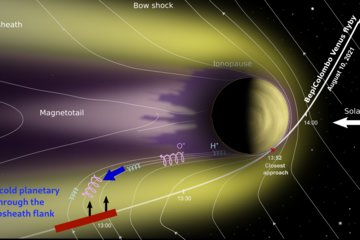All genres
161.
Talk
Dust modelling for the Destiny+ cruise phase. Destiny+ Dust Analyser team meeting, Heidelberg, Germany (2019)
162.
Talk
Interstellar and Interplanetary Dust Modelling for the Destiny+ Mission to (3200) Phaethon. Chiba Institute of Technology, Narashino/Chiba, Japan (2019)
163.
Talk
Galileo, Ulysses, Cassini In-Situ Dust Measurements. International Workshop ''Cosmic Lab" at Chiba Institute of Technology, Narashino/Chiba, Japan (2019)
164.
Talk
Pluto und der Kuiper-Gürtel - Eiswelten am Rand des Sonnensystems. Planetarium Mannheim , Mannheim, Germany (2019)
165.
Talk
Pluto und der Kuiper-Gürtel - Eiswelten am Rand des Sonnensystems. Planetarium Münster , Münster, Germany (2019)
166.
Talk
Cosmic dust - A tool to study remote worlds. Universität Göttingen, Physikalisches Kolloquium, Göttingen, Germany (2019)
167.
Talk
Raumsonde Cassini/Huygens beim Herrn der Ringe. Hildesheimer Gesellschaft für Astronomie , Hildesheim, Germany (2018)
168.
Talk
The MSA Instrument (Mass Spectrum Analyzer) Onboard Bepi Colombo MMO (Mercury Magnetospheric Orbiter). Mercury: Current and Future Science of the Innermost Planet, Columbia, Maryland, USA (2018)
169.
Talk
Cosmic dust - A tool to study remote worlds. Instituto de Geofisica de la Universidad Nacional Autonoma de Mexico, Mexiko-Stadt, Mexico (2018)
170.
Talk
Dust simulations for the Destiny+ mission to (3200) Phaethon. European Planetary Science Congress 2018 , Berlin, Germany (2018)
171.
Talk
Interstellar and Interplanetary Dust Modelling for Destiny+. Dusty Visions Workshop, Madrid, Spain (2018)
172.
Talk
Cassini/Huygens beim Riesenplaneten Saturn. Volkshochschule Mosbach, Binau (Baden) (2018)
173.
Talk
Der Zwergplanet Ceres - Eine geologisch aktive Welt. Hildesheimer Gesellschaft für Astronomie, Hildesheim (2017)
174.
Talk
The Rosetta/Philae Mission to Comet 67P/Churyumov-Gerasimenko. Chiba Institute of Technology, Chiba, Japan (2017)
175.
Talk
Cassini/Huygens beim Riesenplaneten Saturn. Sternwarte und Astronomiemuseum, Sonneberg, Germany (2017)
176.
Talk
Kometenforschung heute und was Amateure dazu beitragen können. ung der Kometenfachgruppe der Vereinigung der Sternfreunde e.V., Gärtringen, Germany (2017)
177.
Talk
Pluto und seine Begleiter - Eiswelten am Rand des Sonnensystems. Bayerische Volkssternwarte, Neumarkt in der Oberpfalz, Germany (2017)
178.
Talk
Pluto und seine Begleiter - Eiswelten am Rand des Sonnensystems. Robert-Mayer-Volks- und Schulsternwarte e.V., Heilbronn, Germany (2017)
179.
Talk
Rosetta/Philae - Landung auf einem Kometen. Vortragsreihe Raumfahrt aus Leidenschaft, Sturrgart, Germany (2016)
180.
Talk
The Rosetta/Philae Mission to Comet 67P/Churymov-Gerasimenko. Physikalisches Kolloquium, Marburg, Germany (2016)











